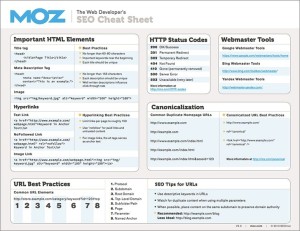
I have worked with a number of web developers and I am pretty sure a number of them will find this SEO cheat sheet useful if they want to build more than just the usual web page.
SEOMoz or now known as just Moz used to have the first version released a few years back and this latest 2013 edition has been updated by Danny Dover. By the way Danny Dover is the author of Search Engine Optimization Secrets, one of the few good SEO books around (in my opinion).
The SEO Cheat sheet can be downloaded here.
Print it out or placed them in your favorite folders after downloading it for a good reference.